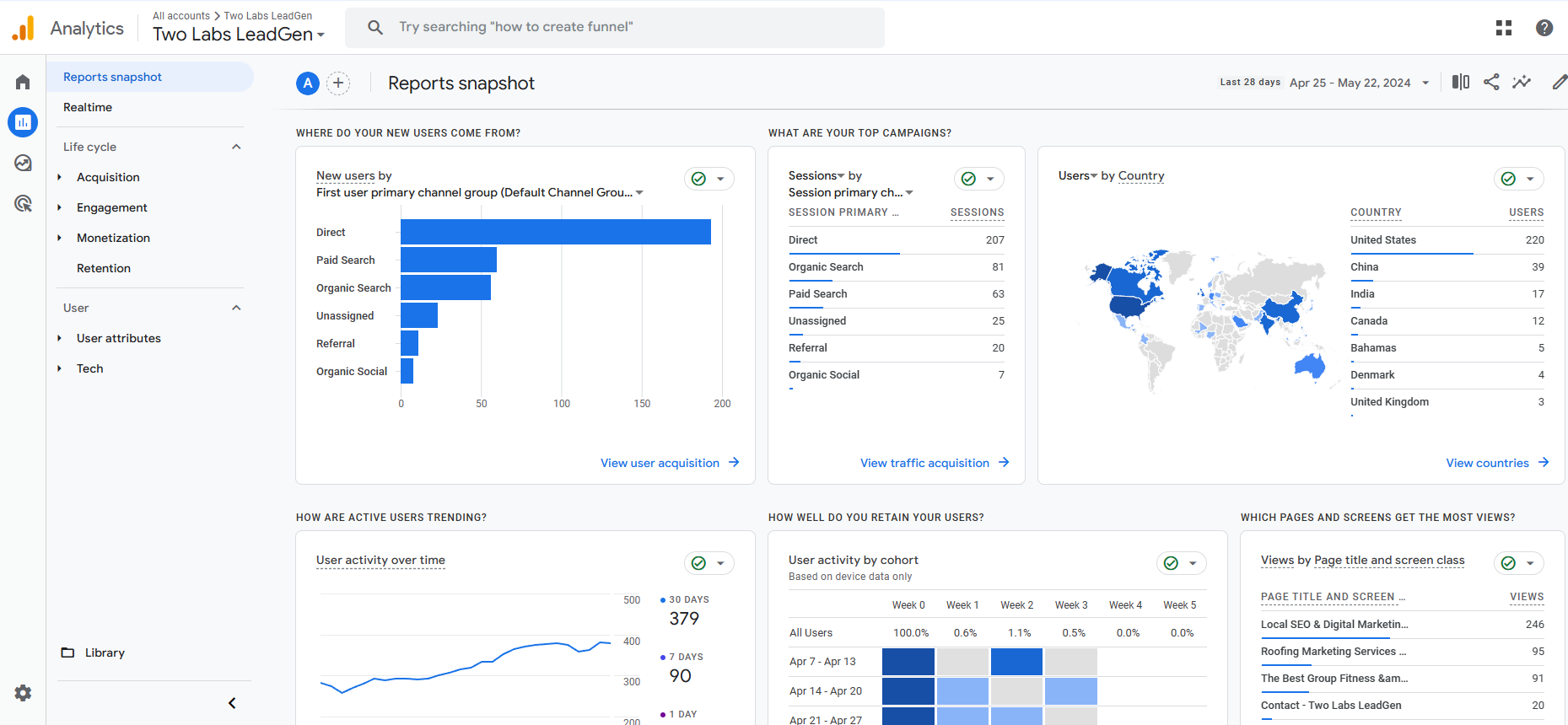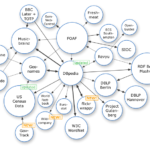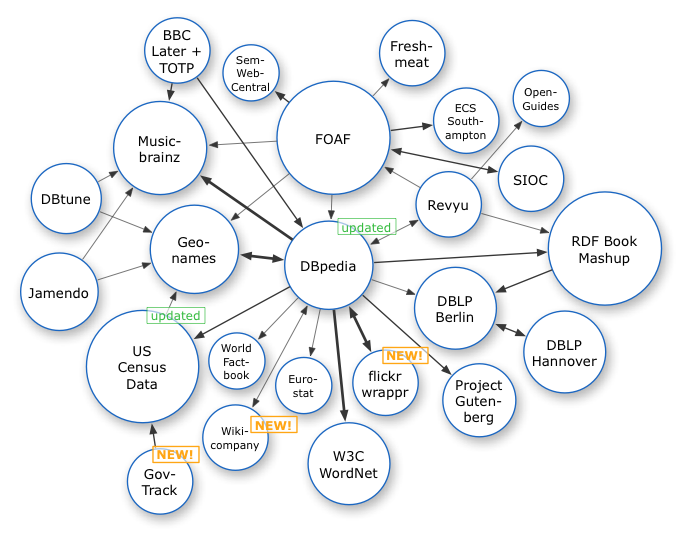Table of Contents
ToggleThere’s no denying the power of data in the digital age, especially when it comes to monitoring and optimizing your website’s performance. With the plethora of information available at our fingertips, harnessing the power of web analytics can be a game-changer for website owners and SEO enthusiasts alike. This guide will investigate the intricacies of using Google Analytics to track and analyze your website’s performance, enabling you to make data-driven decisions that can elevate your online presence to new heights.
Google Analytics, with its robust features and in-depth data analysis capabilities, provides invaluable insights into various aspects of your website’s performance, visitor behavior, and user interaction. By leveraging this tool effectively, you can track key metrics, monitor SEO progress, and gain actionable insights to optimize your website for better search engine visibility and increased organic traffic. This guide will explore how to set up Google Analytics for SEO tracking, analyze vital metrics like organic search traffic and conversion rates, and make informed decisions based on the data gathered.
Understanding how to interpret the data provided by Google Analytics is vital for making informed decisions to enhance your website’s performance. By submerging into key metrics, creating custom reports, and setting specific SEO goals, you can track progress effectively and identify areas for improvement. This guide will walk you through the process of monitoring website performance with Google Analytics, empowering you to harness the power of data to drive successful outcomes for your online presence.
Key Takeaways:
- Google Analytics is a powerful tool for tracking SEO progress and making data-driven decisions.
- Key Metrics such as organic search traffic, bounce rate, and conversion rates provide valuable insights into website performance.
- Custom Reports and goal tracking in Google Analytics help optimize SEO strategies and improve website visibility and user engagement.
Getting Started with Google Analytics
Step-by-Step Guide to Setting Up Google Analytics
It is important to set up Google Analytics correctly to monitor your website’s performance effectively. Follow the step-by-step guide below to get started:
| Create a Google Analytics Account | Get the Tracking Code |
| Start by creating a Google Analytics account on their website. | Obtain the unique tracking code from Google Analytics after creating your account. |
| Fill in the necessary details for your account, including your website name and URL. | Install the tracking code on every page of your website to start gathering data effectively. |
Understanding the Google Analytics Interface
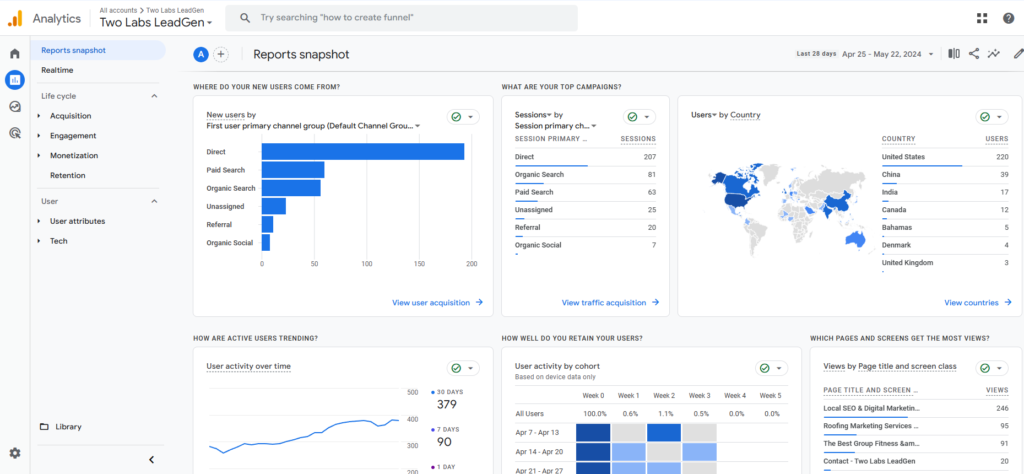
Google Analytics offers a user-friendly interface that provides valuable insights into your website’s performance. The interface comprises various sections, such as Real-Time, Audience, Acquisition, Behavior, and Conversions. Each section offers specific reports and metrics to help you analyze different aspects of your website’s traffic and user behavior.
Plus, within the interface, you can customize reports, set up goals to track specific actions on your website and create segments to analyze different sets of data. By exploring the interface thoroughly, you can gain a comprehensive understanding of your website’s performance and how users interact with your content, ultimately guiding your data-driven decisions to optimize your website for better results.
Key Metrics to Monitor for Website Performance
If you want to track your website’s performance effectively, several key metrics in Google Analytics can provide valuable insights. These include organic search traffic, top landing pages, bounce rate, average session duration, and conversion rates. By monitoring these metrics regularly, you can assess the impact of your SEO efforts, identify areas for improvement, and make data-driven decisions to enhance your website’s performance.
A high organic search traffic indicates that your website is ranking well in search engine results, while a low bounce rate signifies good user engagement. Analyzing conversion rates helps you measure the effectiveness of your website in converting visitors into customers or leads. By focusing on these key metrics and using the data provided by Google Analytics, you can optimize your website for better search engine visibility and user experience.
Types of Google Analytics Reports
Many website owners and digital marketers rely on Google Analytics reports to gain valuable insights into their website performance and user behavior. The platform offers a variety of reports that cover different aspects of website analytics, allowing users to track metrics, analyze trends, and make data-driven decisions. The information provided by these reports is crucial for optimizing SEO strategies and improving overall website efficacy.
| Real-Time Reports: Capturing Live Data | Audience Reports: Knowing Your Visitors |
| Acquisition Reports: Tracking Traffic Sources | Behavior Reports: Understanding User Engagement |
| Conversions Reports: Measuring Success |
Real-Time Reports: Capturing Live Data
You can access Real-Time Reports in Google Analytics to monitor live user activity on your website. These reports provide instant insights into the number of active users, their geographical locations, the pages they are currently viewing, and the traffic sources bringing them to your site. Real-time reports are valuable for tracking the immediate impact of marketing campaigns, website updates, or social media posts. By analyzing real-time data, you can make quick decisions to optimize user experience and engagement in the moment.
Audience Reports: Knowing Your Visitors
Knowing your audience is imperative for tailoring your website content and marketing strategies effectively. Audience Reports in Google Analytics offer detailed information about the demographics, interests, behavior, and devices of your website visitors. By analyzing this data, you can understand who your target audience is, how they interact with your site, and what content resonates with them the most. Armed with audience insights, you can create personalized experiences, improve user engagement, and drive conversions on your website.
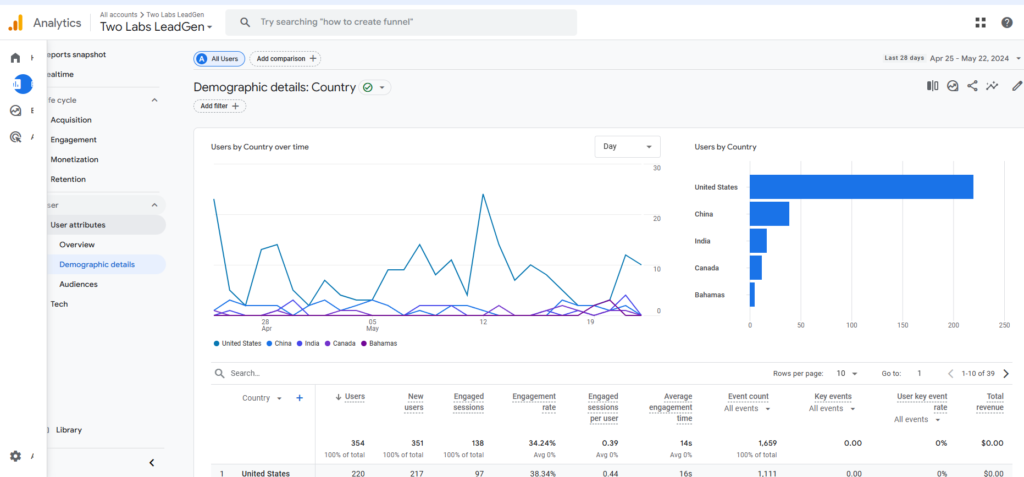
To gain a deeper understanding of your audience, you can utilize features like User Explorer, which provides individual user profiles, and Cohort Analysis, which segments users based on common characteristics. By leveraging Audience Reports in Google Analytics, you can tailor your content, marketing campaigns, and user experience to better meet the needs and preferences of your visitors.
Acquisition Reports: Tracking Traffic Sources
One of the key components of a successful digital marketing strategy is knowing where your website traffic is coming from. Acquisition Reports in Google Analytics help you track the sources of your traffic, including organic search, direct visits, referrals, social media, and paid campaigns. By analyzing Acquisition Reports, you can identify which channels are driving the most valuable traffic to your site, evaluate the effectiveness of your marketing efforts, and allocate resources accordingly to maximize ROI.
Behavior Reports: Understanding User Engagement
Understanding how users interact with your website is imperative for optimizing user experience and driving conversions. Behavior Reports in Google Analytics provide insights into user behavior, such as the top-performing pages, navigation paths, site content, and events. By analyzing this data, you can identify popular pages, high bounce rate areas, and conversion funnels that require improvement. Behavior Reports also help you understand user engagement metrics like average session duration, pages per session, and events tracking, allowing you to optimize your website for better user engagement and retention.
Additionally, Behavior Flow visualizations in Google Analytics offer a graphical representation of how users move through your site, helping you identify bottlenecks and optimize the user journey. By utilizing Behavior Reports effectively, you can tailor your website content, design, and navigation to enhance user experience and drive desired actions.
Conversions Reports: Measuring Success
There’s nothing more crucial in digital marketing than measuring the success of your website in achieving its goals. Conversions Reports in Google Analytics provide valuable insights into user actions that lead to desired outcomes, such as purchases, form submissions, or other conversions. By tracking conversion rates, goals, and e-commerce transactions, you can evaluate the effectiveness of your marketing campaigns, landing pages, and SEO efforts. Conversions Reports help you identify strengths and weaknesses in your conversion funnel, optimize key touchpoints, and drive continuous improvement in your website’s performance.
Engagement metrics like session duration, pages per session, and bounce rate impact user satisfaction and ultimately contribute to conversions. By analyzing Conversions Reports in Google Analytics, you can pinpoint areas for optimization, discover opportunities for growth, and make data-driven decisions to enhance the success of your website.
Analyzing User Behavior for Improved Performance
Visitor Flow: Mapping the User Journey
Keep a close eye on how visitors navigate through your website by leveraging Google Analytics’ Visitor Flow feature. This tool offers valuable insights into the user journey, illustrating the paths users take as they interact with your site. By mapping out the flow, you can identify popular entry points, crucial drop-off points, and potential areas for improvement. Understanding the visitor flow allows you to optimize the user experience, enhance engagement, and ultimately improve website performance.
The Visitor Flow tool in Google Analytics presents a visual representation of how users move from one page to another on your site. By analyzing the flow, you can pinpoint where visitors are spending the most time, where they are dropping off, and which pages are capturing their interest. This data empowers you to make informed decisions about website structure, content placement, and user engagement strategies to create a seamless and compelling user experience.
Tracking visitor flow in Google Analytics enables you to gain a deeper understanding of user behavior and preferences. By identifying the most effective paths through your website and eliminating potential roadblocks, you can optimize the user journey for better conversion rates and increased engagement. Visitor flow analysis is key to making data-driven decisions that drive improved performance and align with your SEO goals.
Event Tracking: Measuring Interactions
There’s more to user behavior than pageviews and session duration. With Google Analytics Event Tracking feature, you can explore deeper into user interactions on your website. This tool allows you to measure specific actions taken by visitors, such as clicks on buttons, downloads of resources, or video views. By tracking these interactions, you can gain insights into user engagement, content effectiveness, and website usability.
There’s a wealth of information to uncover through event tracking in Google Analytics. By setting up event tracking for key interactions on your website, you can measure the impact of different elements and functionalities. Understanding how users engage with specific features can guide you in refining your website’s design, content strategy, and call-to-action placement. Event tracking provides valuable data for optimizing user experience and maximizing conversions.
Flowing seamlessly alongside traditional metrics, event tracking in Google Analytics gives you a comprehensive view of user behavior. By measuring interactions beyond standard pageviews, you can identify high-performing elements, detect areas of improvement, and tailor your website to meet users’ needs. Event tracking is a powerful tool for enhancing performance, refining your SEO strategy, and creating a user-centric online experience.
Content Analysis: Discovering What Captivates Users
There’s immense value in analyzing user engagement with your website’s content using Google Analytics. The Content Analysis feature allows you to uncover which pages are resonating with users, how long they’re staying engaged, and where they’re navigating to next. By delving into content performance metrics, you can identify top-performing pages, popular topics, and areas for content optimization.
This feature in Google Analytics provides valuable insights into what captivates users and drives engagement. By analyzing content performance data, you can identify trends, preferences, and user behaviors that inform your content strategy. Understanding which pieces of content are most effective in attracting and retaining visitors empowers you to create compelling, relevant content that resonates with your target audience.
This granular analysis of content performance equips you with the knowledge needed to optimize your website for user engagement and conversions. By leveraging data from Google Analytics’ Content Analysis feature, you can make informed decisions about content creation, layout design, and user experience enhancements to drive improved performance and SEO success. Understanding what captivates users is necessary for tailoring your website to meet their needs and preferences.
Traffic Source Analysis: Uncovering How Visitors Find You
Organic Search: Assessing SEO Strength
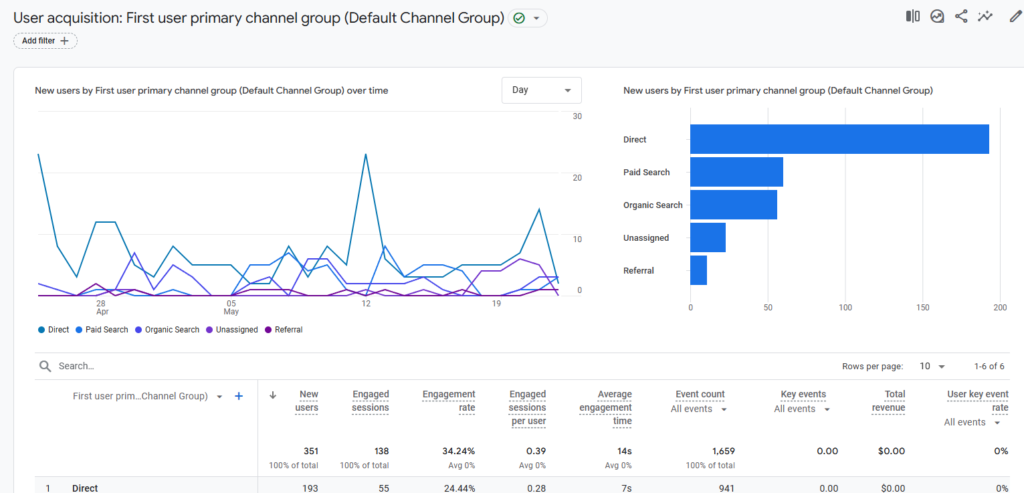
To assess the strength of your website’s SEO efforts, it is crucial to analyze organic search data in Google Analytics. Organic search traffic refers to visitors who find your site through unpaid search results on search engines like Google, Bing, or Yahoo. By tracking metrics such as organic search traffic volume, keyword performance, and landing page effectiveness, you can gain insights into the impact of your SEO strategies. Monitoring changes in organic search traffic over time allows you to understand trends, identify opportunities for improvement, and track the success of your SEO campaigns.
Understanding organic search data can help you optimize your website’s content, structure, and relevancy to improve search engine visibility. By harnessing Google Analytics to analyze organic search metrics, website owners and marketers can make informed decisions to enhance their SEO performance, drive more organic traffic, and boost rankings on search engine result pages.
Utilizing Google Analytics to assess SEO strength through organic search analysis enables website owners to measure the effectiveness of their search engine optimization efforts. By focusing on key organic search metrics and trends, you can refine your SEO strategy, attract more organic traffic, and ultimately increase the visibility and success of your website.
Referral Traffic: Evaluating Link Partnerships
While organic search plays a significant role in driving website traffic, evaluating referral traffic is equally important for understanding how visitors find your site. Referral traffic refers to visitors who land on your website from external sources such as other websites, social media platforms, or online directories. By analyzing referral traffic data in Google Analytics, you can assess the impact of link partnerships, social media campaigns, and content collaborations on your website’s traffic.
Visitors coming from referral traffic sources provide valuable insights into the effectiveness of your external marketing efforts in driving traffic to your site. By monitoring referral traffic metrics and identifying top-performing referral sources, website owners can strengthen their link-building strategies, improve social media engagement, and enhance online partnerships to drive more referral traffic and expand their online presence.
Understanding the behavior and preferences of visitors who arrive through referral traffic sources is necessary for optimizing your external marketing initiatives. By evaluating referral traffic data and analyzing the performance of link partnerships, social media campaigns, and online collaborations, website owners can make data-driven decisions to improve referral traffic, enhance brand visibility, and drive more targeted visitors to their site.
Conversion Optimization Techniques
Setting Up and Monitoring Goals
With the help of Google Analytics, setting up and monitoring goals is crucial for tracking the success of your website’s conversion optimization efforts. Your goals should be specific, measurable, achievable, relevant, and time-bound. By defining clear objectives, such as increasing newsletter sign-ups or e-commerce sales, you can track user actions and measure the effectiveness of your website in driving conversions.
Utilize Google Analytics to set up goals such as destination pages, event tracking, or duration-based actions. By monitoring goal completions, conversion rates, and user behavior, you can gain valuable insights into the performance of your website and make data-driven decisions to optimize for better conversion rates.
Regularly analyze goal conversion data, identify areas for improvement, and adjust your website strategy accordingly. By continuously monitoring and refining your goals in Google Analytics, you can enhance the user experience, drive more conversions, and ultimately improve your website’s performance.
E-commerce Tracking: Measuring Sales Performance
Techniques for e-commerce tracking in Google Analytics enable website owners to measure sales performance accurately. By setting up e-commerce tracking, you can monitor transaction data, revenue, and product performance on your website. E-commerce tracking allows you to gain valuable insights into user behavior, purchase patterns, and the effectiveness of your online sales strategies.
E-commerce tracking techniques in Google Analytics provide detailed information on product sales, average order value, conversion rates, and purchase funnel analysis. By analyzing this data, you can identify top-selling products, optimize pricing strategies, and improve the user experience to drive more sales and revenue on your e-commerce website.
Monitoring e-commerce performance in Google Analytics empowers website owners to make informed decisions to enhance the online shopping experience, increase conversion rates, and maximize revenue generation. By utilizing e-commerce tracking techniques effectively, you can unlock valuable insights to optimize your e-commerce website for better sales performance.
Multi-Channel Funnels: Understanding the Path to Conversion
Conversion tracking in Google Analytics through multi-channel funnels provides a holistic view of the customer journey and the various touchpoints that lead to conversion. By analyzing multi-channel funnels data, you can understand the impact of different marketing channels, such as organic search, social media, and email, on driving conversions on your website.
Multi-channel funnels techniques in Google Analytics help website owners identify the most effective marketing channels, determine the influence of each touchpoint on the conversion path, and optimize marketing strategies for better results. By leveraging multi-channel funnel data, you can allocate budgets effectively, target high-converting channels, and improve overall conversion rates.
Plus, analyzing multi-channel funnels data enables you to optimize marketing campaigns, refine ad targeting, and improve ROI. By understanding the path to conversion and the role of each marketing channel in driving conversions, you can make data-driven decisions to enhance your website’s performance and maximize the impact of your marketing efforts.
Custom Reports and Dashboards for Tailored Insights
Many website owners and digital marketers rely on Google Analytics to track their website performance and make data-driven decisions. Custom reports and dashboards are important tools that allow users to tailor their data analysis to specific goals and objectives. By creating customized views of key metrics and insights, website owners can gain a deeper understanding of their SEO progress and make informed decisions to optimize their online presence.
Creating Custom Reports: Step-by-Step Process
| You | Actions |
| Identify specific metrics and dimensions | Choose the data points that align with your SEO goals |
| Create a new custom report in Google Analytics | Utilize the customization options to set up the report structure |
| Add relevant filters and segments | Refine the data to focus on specific criteria or segments |
By following these steps, website owners can create custom reports in Google Analytics that provide tailored insights into their SEO performance, user behavior, and website engagement.
Building Custom Dashboards for Quicker Access to Data
The ability to build custom dashboards in Google Analytics enables website owners to create personalized views of key metrics and reports for quick access to data. By selecting relevant widgets and arranging them in a dashboard layout, users can monitor their website performance at a glance and identify trends or anomalies. Custom dashboards provide a convenient way to track progress, measure success, and make data-driven decisions in real time.
The process of building custom dashboards involves selecting the most important metrics, arranging them in a logical layout, and adding visualizations for easy interpretation. With custom dashboards, website owners can streamline their data analysis process, gain immediate insights into their SEO efforts, and share relevant information with stakeholders or team members. By customizing dashboards to display the most relevant data, users can ensure they are focusing on the metrics that matter most for their website’s success.
Sharing and Collaboration: Reports for Teams and Stakeholders
Assuming website owners need to collaborate with teams or share insights with stakeholders, Google Analytics offers robust features for sharing custom reports. By granting access to specific users or groups, website owners can ensure that relevant data is shared securely and efficiently. Custom reports can be scheduled for automated delivery, exported in various formats, or shared within the Google Analytics platform for easy access and collaboration. This streamlined process enables teams to work together effectively, make informed decisions based on data, and drive continuous improvement in website performance.
Useful Tips for Advanced Google Analytics Features
- Segmenting Data for Deeper Analysis
|
You can segment your data in Google Analytics to gain deeper insights into user behavior and website performance. By creating specific segments based on various factors such as traffic sources, user demographics, or behavior, you can analyze how different groups interact with your site. |
This segmentation allows you to understand which segments drive the most conversions, have the highest engagement rates, or exhibit specific patterns. By segmenting your data, you can tailor your marketing strategies and website content to target specific audiences more effectively. |
- Integrating Google Analytics with Other Tools
|
You can integrate Google Analytics with other tools such as Google Ads, CRM software, or heat mapping tools to enhance your data analysis capabilities. By combining data from multiple sources, you can create a comprehensive view of user interactions and campaign performance. |
Integrating Google Analytics with other tools allows you to track the customer journey more accurately, measure the impact of your marketing efforts across different platforms, and make informed decisions based on consolidated data. This integration enhances your ability to optimize campaigns and improve overall website performance. |
- Setting Alerts for Performance Anomalies
|
By setting up alerts in Google Analytics for performance anomalies, you can proactively monitor website metrics and receive notifications when significant changes occur. Alerts can be customized based on specific metrics like traffic fluctuations, bounce rates, or conversion rates. |
Setting alerts helps you quickly identify issues that may impact website performance and take immediate action to address them. This feature allows you to stay on top of changes in real-time, mitigate potential issues, and continuously improve your website’s user experience and SEO performance. |
Segmenting Data for Deeper Analysis
You can segment your data in Google Analytics to gain deeper insights into user behavior and website performance. By creating specific segments based on various factors such as traffic sources, user demographics, or behavior, you can analyze how different groups interact with your site. This segmentation allows you to understand which segments drive the most conversions, have the highest engagement rates, or exhibit specific patterns. By segmenting your data, you can tailor your marketing strategies and website content to target specific audiences more effectively.
Integrating Google Analytics with Other Tools
Google Analytics allows you to integrate with other tools such as Google Ads, CRM software, or heat mapping tools to enhance your data analysis capabilities. By combining data from multiple sources, you can create a comprehensive view of user interactions and campaign performance. Integrating Google Analytics with other tools allows you to track the customer journey more accurately, measure the impact of your marketing efforts across different platforms, and make informed decisions based on consolidated data. This integration enhances your ability to optimize campaigns and improve overall website performance.
Setting Alerts for Performance Anomalies
Little
You can set up alerts in Google Analytics for performance anomalies, enabling you to proactively monitor website metrics and receive notifications when significant changes occur. These alerts can be customized based on specific metrics like traffic fluctuations, bounce rates, or conversion rates. Setting alerts helps you quickly identify issues that may impact website performance and take immediate action to address them. This feature allows you to stay on top of changes in real time, mitigate potential issues, and continuously improve your website’s user experience and SEO performance.
Factors Affecting Website Performance and Analytics
For analyzing website performance and making data-driven decisions, it is crucial to consider various factors that can impact user experience and overall success. An important aspect to evaluate is page load times and their impact on user engagement. Slow-loading pages can deter visitors and lead to higher bounce rates, affecting your SEO efforts. By analyzing page load times in Google Analytics, you can identify areas for optimization and improve the overall user experience to drive better results.
Analyzing Page Load Times and Their Impact on User Experience
- Slow-loading pages can lead to higher bounce rates
- Optimizing page load times can improve user engagement
- Google Analytics provides insights into page load performance
For optimizing website performance, it is vital to differentiate between mobile and desktop traffic. With the increasing use of mobile devices for internet browsing, ensuring that your website is optimized for all devices is crucial. Google Analytics can help you track the performance of both mobile and desktop traffic, allowing you to make informed decisions on how to optimize your website for all users.
Mobile Versus Desktop Traffic: Optimizing for All Devices
- Mobile traffic is increasing rapidly
- Responsive design is key for optimizing user experience
- Google Analytics provides data on mobile versus desktop performance
Any effective website analysis should also consider the impact of social media on website traffic. Social media platforms can drive significant traffic to your website, impacting SEO results and overall performance. By assessing the impact of social media on website traffic using Google Analytics, you can tailor your social media strategy to maximize traffic and engagement on your site.
Assessing the Impact of Social Media on Website Traffic
- Social media can be a major source of website traffic
- Engagement on social platforms can lead to increased website visits
- Google Analytics offers insights into social media referral traffic
Pros and Cons of Relying on Google Analytics
| Advantages | Limitations |
| Provides detailed insights into website performance | Potential data privacy concerns |
| Tracks various metrics for SEO progress | May have sampling limitations with large datasets |
| Allows customization for specific analysis | Requires technical expertise for accurate setup |
| Helps in making data-driven decisions | Not all data is 100% accurate or up to date |
Advantages of Using Google Analytics for Website Monitoring
Analytics is a powerful tool that provides website owners with detailed insights into various aspects of their site’s performance. From tracking SEO progress to measuring user engagement, Google Analytics offers a comprehensive suite of metrics to analyze. Website owners can make data-driven decisions based on the valuable information provided, helping them optimize their sites for better visibility and user experience.
Additionally, Google Analytics allows for customization, enabling users to focus on specific metrics that matter most to them. This flexibility in analysis helps website owners tailor their monitoring efforts to align with their unique goals and objectives. By leveraging the customization options available, users can gain deeper insights into their website performance and make informed decisions accordingly.
Furthermore, Google Analytics aids in tracking various metrics vital for SEO progress. From organic search traffic to conversion rates, website owners can easily monitor key indicators of their online presence. With the ability to segment data, create custom reports, and set up goal tracking, Google Analytics empowers users to continually improve their SEO strategies and achieve better results over time.
Limitations and Considerations When Using Google Analytics
On the other hand, website owners must be aware of the limitations and considerations when relying on Google Analytics for website monitoring. While the platform provides valuable insights, there are potential data privacy concerns to consider. It is vital to adhere to data protection regulations and ensure that user information is handled responsibly to maintain trust and compliance.
Moreover, Google Analytics may have sampling limitations, especially with large datasets, which can impact the accuracy of the insights generated. Website owners should be cautious when interpreting data from sampled reports and consider the potential margin of error in their analysis. Additionally, setting up Google Analytics correctly may require technical expertise, making it important to ensure proper configuration to obtain reliable data for decision-making.
To maximize the benefits of Google Analytics, website owners should acknowledge that not all data provided is 100% accurate or up to date. While the platform offers valuable metrics for analysis, users should exercise caution when making critical decisions based solely on the data presented. It is advisable to cross-reference information from multiple sources and validate findings to ensure a comprehensive understanding of website performance.
Advanced Strategies for Maximizing Data Insights

Leveraging A/B Testing Based on Google Analytics Data
Now, A/B testing is a powerful strategy that uses variations of a webpage to determine which one performs better in terms of user engagement, conversions, and other key metrics. By leveraging Google Analytics data to inform A/B testing decisions, website owners can gain valuable insights into user behavior, preferences, and interactions. This data-driven approach allows for precise testing of different elements on a webpage to optimize website performance and drive better results.
Predictive Analytics: Forecasting Future Trends
Data-driven decision-making based on predictive analytics can help website owners anticipate future trends and make strategic decisions to stay ahead of the curve. By analyzing historical data and trends using tools like Google Analytics, businesses can forecast potential outcomes and plan their SEO strategies accordingly. This proactive approach enables website owners to adapt to changing market conditions and capitalize on emerging opportunities.The use of predictive analytics based on Google Analytics data empowers website owners to make informed decisions, anticipate market trends, and tailor their SEO strategies for future success. By leveraging historical data and advanced analytics tools, businesses can stay ahead of the competition and position themselves for long-term growth.
Cross-Device Tracking and Reporting for a Seamless Analysis
Leveraging cross-device tracking and reporting allows website owners to seamlessly analyze user behavior across different devices, ensuring a comprehensive understanding of how users interact with their website. By utilizing Google Analytics’ cross-device tracking capabilities, businesses can gain valuable insights into customer journeys, preferences, and conversion paths across multiple devices.
Creating Actionable Plans From Analytics Insights
Turning Data Into Decisions: Practical Examples
While analyzing data in Google Analytics provides valuable insights into website performance, the true power lies in converting those insights into actionable plans. For example, if the data shows a high bounce rate on a particular landing page, it indicates a potential issue in user engagement. As a result, implementing strategies to enhance the page’s content, navigation, or load speed can be a practical step toward improving user retention and reducing bounce rates.
Prioritizing Changes Based on Analytics Findings
Insights from Google Analytics can help prioritize changes based on their potential impact on website performance. By focusing on areas with the highest impact, such as optimizing high-traffic pages or targeting specific keywords with high conversion rates, website owners can make strategic decisions that yield tangible results. Utilizing data to prioritize changes ensures that resources are allocated efficiently for maximum ROI.
Examples Continuous Improvement Cycle: Analyze, Optimize, Repeat
Some successful examples of continuous improvement cycles based on analytics data include regularly reviewing website data to identify trends and patterns, optimizing content based on keyword performance, and testing different strategies to gauge their effectiveness. By following a structured approach of analyzing, optimizing, and repeating the cycle, website owners can achieve sustained growth and improved online visibility.
Maintaining Privacy and Compliance in Analytics
Understanding GDPR and Analytics Data
GDPR regulations have a significant impact on how websites collect, store, and process user data, including analytics information. It is crucial for website owners to understand the implications of GDPR compliance when using tools like Google Analytics to track website performance.
Not adhering to GDPR guidelines can lead to hefty fines and damage to a website’s reputation. Ensuring that analytics data collection is GDPR-compliant is vital for maintaining user trust and protecting personal data.
Implementing GDPR-compliant practices in analytics involves obtaining proper consent for data collection, anonymizing IP addresses, and ensuring transparency in data processing procedures.
Anonymizing IP Addresses for User Privacy
GDPR mandates the protection of user data, including IP addresses, to ensure privacy and compliance with data protection regulations. Anonymizing IP addresses in analytics tools like Google Analytics is a crucial step in safeguarding user information.
For instance, anonymizing IP addresses involves masking the last octet of the IP address, making it impossible to track individual users’ precise locations. This process helps maintain user privacy while still allowing website owners to gather valuable insights from analytics data.
By anonymizing IP addresses, website owners can demonstrate their commitment to data privacy and ensure compliance with GDPR regulations regarding the processing of personal data.
Consent Management for Analytics Tracking
Addressing consent management in analytics tracking is vital for ensuring compliance with privacy regulations like GDPR. Website owners must obtain explicit consent from users before tracking their online activity through tools like Google Analytics.
Another aspect of consent management involves offering users clear options to opt in or opt-out of data collection, providing transparency and control over their personal information. Consent management platforms can help streamline the process of obtaining and managing user consent for analytics tracking.
Implementing robust consent management practices not only helps maintain compliance with privacy regulations but also fosters trust and transparency between website owners and users regarding data collection and processing.
Best Practices for Monitoring and Enhancing Website Performance
Regular Health Checks Using Google Analytics
Using Google Analytics for regular health checks of your website is crucial for maintaining optimal performance. By monitoring key metrics such as organic search traffic, top landing pages, bounce rates, average session duration, and conversion rates, you can gain valuable insights into the effectiveness of your SEO efforts. Analyzing trends and patterns in data over time allows you to identify areas for improvement and make data-driven decisions to enhance your website’s user experience and search engine visibility.
Regular health checks using Google Analytics help you track the impact of changes made to your website, assess the success of your optimization strategies, and identify any potential issues that may be affecting your site’s performance. By staying diligent in monitoring and analyzing your website data, you can continuously refine your SEO tactics, improve engagement metrics, and drive more organic traffic to your site.
Utilizing the wealth of information provided by Google Analytics for regular health checks is a crucial practice for website owners and SEO enthusiasts. By leveraging the insights and reports available, you can stay informed about your website’s performance, make informed decisions to optimize your strategies, and ultimately achieve your SEO goals.
Training and Resources for Staying Ahead in Analytics
Analytics is a powerful tool for monitoring website performance and making data-driven decisions. It is crucial for website owners and SEO professionals to stay ahead in analytics by continuously learning and adapting to new trends and strategies. Utilizing online resources, attending training courses, and staying updated on industry best practices can help you enhance your analytical skills and make the most out of tools like Google Analytics.
It is important to invest time and effort into learning analytics to stay competitive in the digital landscape. By understanding how to interpret data, identify key performance indicators, and implement effective strategies, you can maximize the potential of analytics tools for monitoring website performance and driving growth.
The Role of Professional Analytics Services
Analytics services play a crucial role in helping businesses leverage data effectively to improve their online presence and make informed decisions. Professionals in the analytics field have the expertise and experience to interpret complex data sets, identify trends, and recommend strategies for optimizing website performance. By partnering with professional analytics services, businesses can gain a competitive edge, unlock valuable insights, and drive measurable results in their online marketing efforts.
This section details the importance of incorporating professional analytics services into your digital strategy, highlighting the benefits of working with experts in the field. Whether you require advanced data analysis, customized reporting, or strategic insights, professional analytics services can provide the necessary expertise and support to help you achieve your digital marketing goals.
Conclusion: Monitoring Website Performance With Google Analytics For Data-Driven Decisions
Considering all the points discussed, it is evident that Google Analytics serves as an invaluable tool for monitoring website performance and making data-driven decisions to optimize SEO strategies. By leveraging the myriad features and reports within Google Analytics, website owners and SEO enthusiasts can gain valuable insights into key metrics such as organic search traffic, bounce rate, average session duration, conversion rates, and more. Analyzing these metrics allows for a comprehensive understanding of user behavior, traffic sources, and website performance, enabling informed decisions to enhance SEO efforts.
Tracking goal completions, analyzing trends and patterns in data, identifying areas for improvement, testing, and experimenting with different SEO tactics are crucial steps in the process of utilizing Google Analytics for optimizing website performance. By setting specific and measurable SEO goals, monitoring progress, and adapting strategies based on data-driven insights, website owners can drive better search engine visibility, increase organic traffic, and ultimately boost conversions. Google Analytics empowers website owners to refine their optimization approach, improve user experience, and stay ahead of the competition in the dynamic digital landscape.
Therefore, leveraging Google Analytics for monitoring website performance and making data-driven decisions is vital for achieving SEO success. By harnessing the power of data analytics, website owners can gain a competitive edge, refine their SEO strategies, and drive tangible results. With continuous monitoring, analysis, and adaptation, website owners can optimize their websites for better search engine rankings, increased organic traffic, and enhanced user engagement. Google Analytics remains a cornerstone tool for any website owner looking to make informed decisions and propel their online presence to new heights.
People Also Ask
Q: What is Google Analytics?
A: Google Analytics is a web analytics tool that provides insights into website performance, visitor behavior, and user interaction.
Q: How can Google Analytics help in monitoring website performance?
A: Google Analytics allows users to track and measure various metrics to assess SEO progress, such as organic search traffic, bounce rate, average session duration, and conversion rates.
Q: Why is monitoring organic search traffic important?
A: Organic search traffic indicates how well a website is ranking in search engine results for relevant keywords, providing insights into the effectiveness of SEO strategies.
Q: How can bounce rate impact website performance?
A: Bounce rate measures the percentage of visitors who leave a website after viewing only one page, with a high bounce rate suggesting potential issues with content or user experience that need to be addressed.
Q: Why is tracking conversion rates imperative for website optimization?
A: Conversion rates measure the percentage of website visitors who complete desired actions, offering insights into the effectiveness of SEO efforts and guiding optimizations to drive more conversions.

